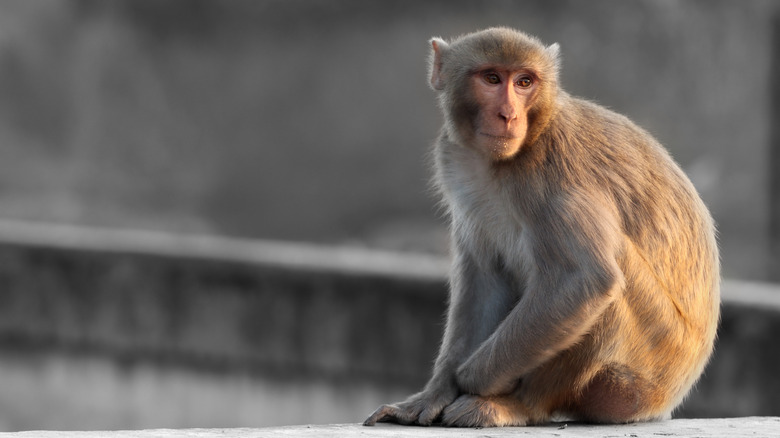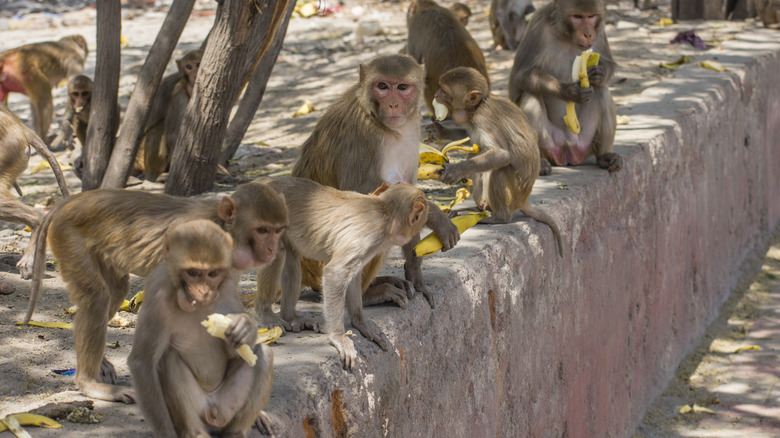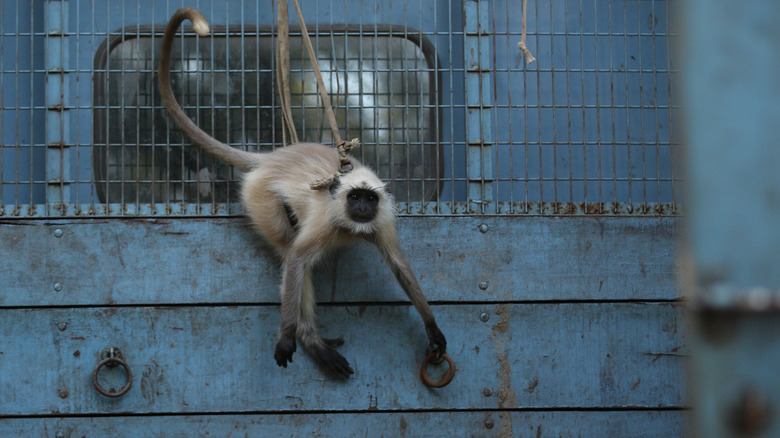The Tragic 2007 Death Of One Delhi Mayor Was Caused By A Ruthless Gang Of Monkeys
Stories about animals running wild are usually chaotic crowd pleasers. Who could forget how the internet came together in February 2015 to laugh and marvel at the adventures of the two llamas that got loose from the assisted living facility they were visiting in Sun City, Arizona? The two adorable escapees led authorities on a wild chase around the city as the world watched and cheered them on, as reported by Buzzfeed, and were eventually lassoed and brought back to safety before they or anyone else got hurt. Unfortunately, not all stories about animals running free in urban environments are hilarious capers in which all's well that ends well. In 2007, the rhesus monkeys found roaming the streets together in the capital city of New Delhi, India, often in large, marauding swarms, tragically caused the death of a local politician.
The New York Times reported in 2007 that the ever-increasing rhesus population and the related human-monkey run-ins were the result of quick urban growth. Delhi had traditionally been home to a large population of rhesus monkeys, but as the city's human population rapidly grew each year by half a million residents, this encroached upon the monkeys' habitats. The displaced simians responded by migrating to the city's more central, populous areas, even taking up residence at Rashtrapati Bhavan, the palace residence of the president. Furthermore, the monkeys were seen by many as representatives for the Hindu monkey god Hanuman, and some people went so far as to risk fines and feed the monkeys in tribute.
Monkey attack leads to deadly fall
On October 20, 2007, the city's deputy mayor, Surinder Singh Bajwa, fell from terrace as he tried to fight off a group of monkeys. Per The Times of India, the attack surprised Bajwa as he was walking across his terrace and in the scuffle, he lost his balance and plummeted to the ground. He was brought to Apollo Hospital but died one day later; the BBC reported that he'd sustained head injuries in the fall. Bajwa had been elected to his post in the Municipal Corporation of Delhi in April 2007 and served as vice president of the Delhi Bharatiya Janata Party or BJP, one of India's major political parties. He was 52 years old and survived by his wife and son.
The attack wasn't an isolated incident. The New York Times reported in November 2007 on a monkey attack within a Delhi neighborhood that resulted in several injuries, with children making up the majority of those hurt. The monkey problem had been a topic of discussion and controversy city for years. In 2000, the government had a lawsuit brought against it for failing to take action; the lawsuit was still in process seven years later. After Bajwa's death, authorities acknowledged that action was necessary. Mayor Aarti Mehra told the Times, "after the incident, the process has really speeded up," noting the new hiring of 35 new monkey catchers and plans for a total of 100 catchers to go after the city's 20,000 to 25,000 monkeys
It was money versus monkey at one point
Delhi's monkey problems may have received more attention and inspired plans for combating the rhesus attacks against people after the death of Surinder Singh Bajwa, but they continued anyway. As Major Aarti Mehra explained to The New York Times in 2007, "We have a serious problem because of our religious ways. People feed them liberally. But they do attack. In the past three years, there have been 2,000 cases of monkey bite in Delhi." In 2014, Salon reported that one attempt at mitigating the "derelict" rhesus throngs involved monkey catchers using larger langur monkeys, recognizable by their grey fur and black faces and ears as well as considerable size, to intimidate the smaller rhesus monkeys. However, it's actually illegal to own a langur, and after the country's environmental ministry announcement in 2012 that langur owners would be prosecuted, Delhi canceled contracts with the 30 "langur men" who'd patrolled the city with their primate coworkers.
One solution involved hiring people to serve as "monkey impersonators" and take on the intimidation roles that had been filled by langurs. The Guardian reported that housing and urban development minister Venkaiah Naidu announced the employment of about 40 people who would imitate langurs in an attempt to scare off the smaller, more violent rhesus monkeys. Chief health officer for the New Delhi Municipal Corporation PK Sharma explained that the impersonators "are village performers and some of them have played monkeys on stage. So they mimic the sound of the langur and it scares the smaller, red-faced macaques away."


